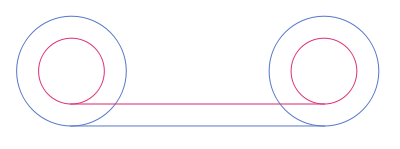
Aristotle's wheel paradox
Encyclopedia

Paradox
Similar to Circular reasoning, A paradox is a seemingly true statement or group of statements that lead to a contradiction or a situation which seems to defy logic or intuition...
from the Greek
Ancient Greece
Ancient Greece is a civilization belonging to a period of Greek history that lasted from the Archaic period of the 8th to 6th centuries BC to the end of antiquity. Immediately following this period was the beginning of the Early Middle Ages and the Byzantine era. Included in Ancient Greece is the...
work Mechanica traditionally attributed to Aristotle
Aristotle
Aristotle was a Greek philosopher and polymath, a student of Plato and teacher of Alexander the Great. His writings cover many subjects, including physics, metaphysics, poetry, theater, music, logic, rhetoric, linguistics, politics, government, ethics, biology, and zoology...
. There are two wheel
Wheel
A wheel is a device that allows heavy objects to be moved easily through rotating on an axle through its center, facilitating movement or transportation while supporting a load, or performing labor in machines. Common examples found in transport applications. A wheel, together with an axle,...
s, one within the other, whose rims take the shape of two circle
Circle
A circle is a simple shape of Euclidean geometry consisting of those points in a plane that are a given distance from a given point, the centre. The distance between any of the points and the centre is called the radius....
s with different diameter
Diameter
In geometry, a diameter of a circle is any straight line segment that passes through the center of the circle and whose endpoints are on the circle. The diameters are the longest chords of the circle...
s. The wheels roll without slipping for a full revolution. The paths traced by the bottoms of the wheels are straight lines, which are apparently the wheels' circumference
Circumference
The circumference is the distance around a closed curve. Circumference is a special perimeter.-Circumference of a circle:The circumference of a circle is the length around it....
s. But the two lines have the same length, so the wheels must have the same circumference, contradicting the assumption that they have different sizes: a paradox.
The fallacy
Fallacy
In logic and rhetoric, a fallacy is usually an incorrect argumentation in reasoning resulting in a misconception or presumption. By accident or design, fallacies may exploit emotional triggers in the listener or interlocutor , or take advantage of social relationships between people...
is the assumption that the smaller wheel indeed traces out its circumference, without ensuring that it, too, rolls without slipping on a fixed surface. In fact, it is impossible for both wheels to perform such motion. Physically, if two joined concentric wheels with different radii were rolled along parallel lines then at least one would slip; if a system of cogs was used to prevent slippage then the wheels would jam. A modern approximation of such an experiment is often performed by car
Čar
Čar is a village in the municipality of Bujanovac, Serbia. According to the 2002 census, the town has a population of 296 people.-References:...
drivers who park too close to a curb. The car's outer tire rolls without slipping on the road surface while the inner hubcap both rolls and slips across the curb; the slipping is evidenced by a screeching noise.
Mathematically, the number of points in the inner circle is equal to the number of points in the outer circle, i.e. there is a bijection
Bijection
A bijection is a function giving an exact pairing of the elements of two sets. A bijection from the set X to the set Y has an inverse function from Y to X. If X and Y are finite sets, then the existence of a bijection means they have the same number of elements...
between them. This does not apply to physical wheels because they are made of discrete atoms, so the number of atoms of the larger wheel is greater if the wheels have the same density, width and thickness (only their radii are different).

